The Cervical Cancer Treatment Market is estimated to be valued at USD 9.2 billion in 2025 and is projected to reach USD 15.9 billion by 2035, registering a compound annual growth rate (CAGR) of 5.6% over the forecast period.
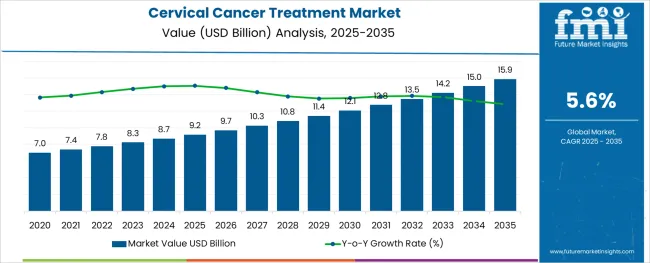
The cervical cancer treatment market is progressing steadily owing to the global emphasis on early diagnosis, improved treatment access, and integration of precision oncology in gynecological care. Rising awareness campaigns, enhanced screening infrastructure, and growing support from public health organizations have contributed to a more proactive approach toward cervical cancer management.
Technological advancements in radiation therapy, targeted drug delivery, and magnetic resonance guided procedures are reshaping treatment protocols. Healthcare providers are increasingly adopting patient specific treatment plans that minimize invasiveness and improve survival outcomes.
With increased funding for women’s health research and the adoption of integrated care models, the market outlook remains promising. Innovations in non invasive imaging, enhanced safety profiles of treatment systems, and demand for effective therapies with minimal side effects are driving ongoing growth and strategic investments in this space.
The market is segmented by Type, Treatment, and End User and region. By Type, the market is divided into Open system and Closed system. In terms of Treatment, the market is classified into Low Field Strength, Mid Field Strength, and High Field Strength.
Based on End User, the market is segmented into Hospitals, Imaging Centers, Ambulatory Surgical Centers, and Others. Regionally, the market is classified into North America, Latin America, Western Europe, Eastern Europe, Balkan & Baltic Countries, Russia & Belarus, Central Asia, East Asia, South Asia & Pacific, and the Middle East & Africa.
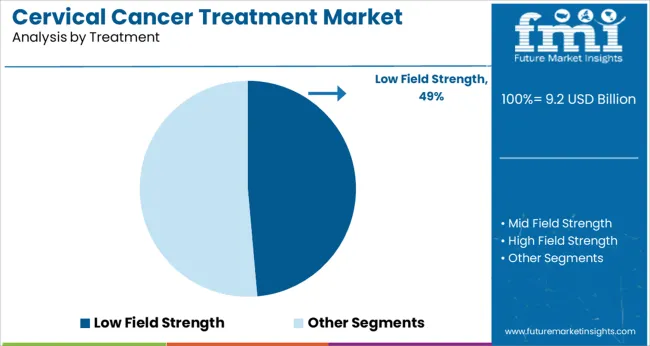
The low field strength segment is projected to represent 48.60% of total market revenue by 2025 within the treatment category, positioning it as the leading option. This dominance is attributed to its compatibility with gynecologic imaging protocols, lower operational costs, and reduced risks associated with prolonged exposure.
Low field strength systems are widely utilized in radiation therapy planning and image guided interventions, offering sufficient imaging clarity while improving patient safety. Their reliability and affordability make them particularly suitable for deployment in emerging healthcare systems where cost efficiency and accessibility are key priorities.
Moreover, clinical acceptance has been rising due to the ability of these systems to provide adequate diagnostic and treatment guidance without compromising comfort or increasing complexity. This segment continues to lead as health systems seek dependable and budget friendly treatment solutions for managing cervical cancer.
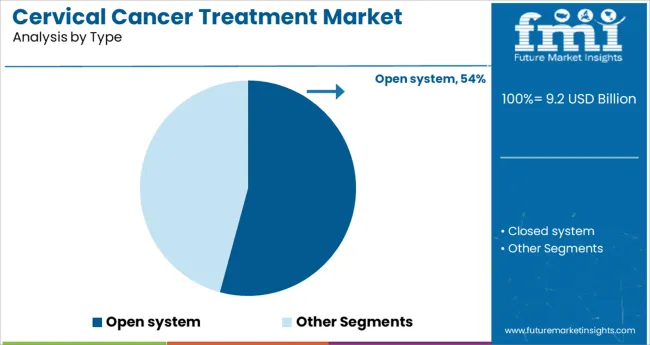
The open system segment is expected to contribute 54.20% of total market revenue by 2025 under the type category, making it the most preferred segment. This leadership is driven by enhanced patient comfort, ease of access during imaging or therapy, and reduced claustrophobia related challenges.
Open systems provide greater flexibility for positioning and accommodate a wider patient demographic, which improves diagnostic accuracy and treatment outcomes. In cervical cancer treatment, where precise targeting and continuous monitoring are critical, open systems support improved workflow integration and procedural success.
Their design also facilitates interdisciplinary collaboration between radiologists and oncologists, further enhancing treatment precision. As patient centric care models evolve and comfort becomes a priority in treatment design, open systems have gained significant adoption and continue to set the standard in cervical cancer treatment equipment.
The market is largely driven by developments in oncology technology, rising cervical cancer rates, new imaging devices developed by market leaders, raising awareness of the causes and risk factors for cervical cancer and its treatment, growing importance of women's healthcare, and changes in women's lifestyles.
The expansion of the cervical cancer treatment market has been driven by the rising incidence of cervical cancer and the rising awareness of cervical cancer among women. Cervical cancer is the seventh most prevalent cancer worldwide, according to the World Cancer Research Fund International. Around the world, 604,000 women were given a cervical cancer diagnosis in 2024, and about 342,000 of them died from the disease. Multiple pregnancies and unprotected sexual contact raise the risk of cervical cancer. Additionally, the number of people who develop cervical cancer is growing as a result of the rising trend of the use of alcohol and tobacco products.
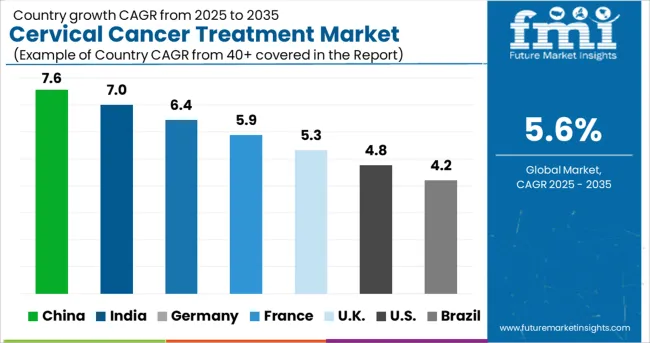
The cervical cancer treatment market is broadly divided into seven major regions, North America, Latin America, Europe, East Asia, South Asia, Oceania, and the Middle East and Africa.
North America is the leading region in the global cervical cancer treatment market owing to the better awareness among people about health care and the latest advanced healthcare technologies in the region.
Along with North America, the market for cervical cancer treatments in Europe is anticipated to develop profitably during the coming years Due to the increasing consumer awareness and the presence of regional players with a history of success.
The East Asian region is predicted to show lucrative growth owing to the rising number of health initiatives by private and government firms, and the adoption of better technologies.
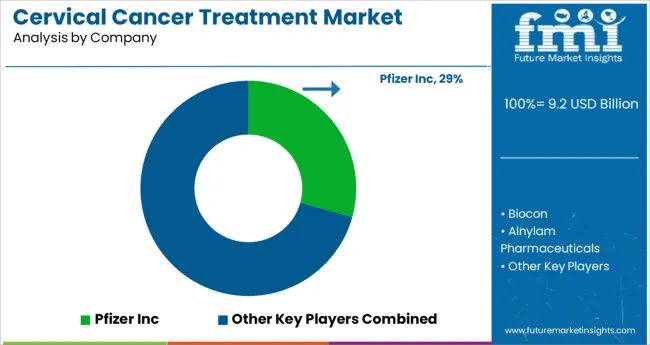
Pfizer Inc, Biocon, Alnylam Pharmaceuticals, Novartis, GlaxoSmithKline, Genentech, Hetero, Eli Lilly, ALLERGAN, Actavis Pharma Company, Bristol-Myers Squibb Company.
| Report Attributes | Details |
|---|---|
| Growth Rate | CAGR of 5.6% 2025 to 2035 |
| Base Year for Estimation | 2024 |
| Historical Data | 2012 to 2024 |
| Forecast Period | 2025 to 2035 |
| Qualitative Units | Revenue in USD Billion, and CAGR from 2025 to 2035 |
| Report Coverage | Revenue Forecast, Company Ranking, Competitive Landscape, Growth Factors, and Trends |
| Segment Covered | Type, Treatment, End User, Region |
| Region Covered | North America; Latin America; Europe; East Asia; South Asia; Oceania; Middle East Africa |
| Key Countries Profiled | USA, Canada, Brazil, Mexico, Germany, UK, France, Spain, Italy, China, Japan, South Korea, Malaysia, Singapore, Australia, New Zealand, GCC, South Africa, Israel |
| Key Players | Pfizer Inc; Biocon; Alnylam Pharmaceuticals; Novartis; GlaxoSmithKline; Genentech; Hetero; Eli Lilly; ALLERGAN; Actavis Pharma Company; Bristol-Myers Squibb Company |
| Customization | Available Upon Request |
The global cervical cancer treatment market is estimated to be valued at USD 9.2 USD billion in 2025.
It is projected to reach USD 15.9 USD billion by 2035.
The market is expected to grow at a 5.6% CAGR between 2025 and 2035.
The key product types are open system and closed system.
low field strength segment is expected to dominate with a 48.6% industry share in 2025.






Full Research Suite comprises of:
Market outlook & trends analysis
Interviews & case studies
Strategic recommendations
Vendor profiles & capabilities analysis
5-year forecasts
8 regions and 60+ country-level data splits
Market segment data splits
12 months of continuous data updates
DELIVERED AS:
PDF EXCEL ONLINE
Cervical Pillow Market Forecast and Outlook 2025 to 2035
The Cervical Spacer Systems Market is segmented by 12x12 mm, 12x14 mm, 14x16 mm and 16x18 mm Cervical Spacer Systems, from 2025 to 2035
Cervical Spine System Market – Innovations, Trends & Forecast 2025 to 2035
Cervical Retractors Market
Cervical Implants Market
Cervical Dysplasia Treatment Market Size and Share Forecast Outlook 2025 to 2035
Cervical Cancer Screening Market - Trends & Forecast 2025 to 2035
Intelligent Cervical Massager Market Size and Share Forecast Outlook 2025 to 2035
Cancer Registry Software Market Size and Share Forecast Outlook 2025 to 2035
Cancer Biological Therapy Market Size and Share Forecast Outlook 2025 to 2035
Cancer Diagnostics Market Analysis - Size, Share and Forecast 2025 to 2035
Cancer Biopsy Market - Growth & Technological Innovations 2025 to 2035
Cancer Vaccines Market Analysis by Technology, Treatment Method, Application and Region from 2025 to 2035
Cancer Gene Therapy Market Overview – Trends & Future Outlook 2024-2034
Cancer-focused Genetic Testing Service Market Analysis – Growth & Industry Insights 2024-2034
Cancer Tissue Diagnostic Market Trends – Growth & Industry Forecast 2024-2034
Cancer Supportive Care Products Market Trends – Growth & Forecast 2020-2030
Cancer Antigens Market
Pet Cancer Therapeutics Market Insights - Growth & Forecast 2024 to 2034
Skin Cancer Detection Devices Market Size and Share Forecast Outlook 2025 to 2035

Thank you!
You will receive an email from our Business Development Manager. Please be sure to check your SPAM/JUNK folder too.
Chat With
MaRIA